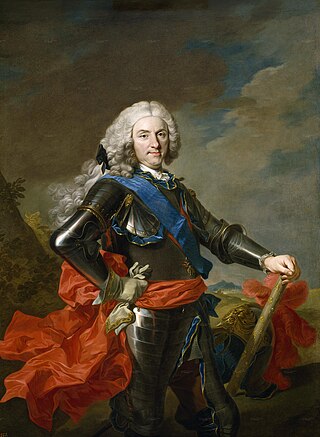
Philip V was King of Spain from 1 November 1700 to 14 January 1724 and again from 6 September 1724 to his death in 1746. His total reign is the longest in the history of the Spanish monarchy, surpassing Philip IV. Although his ascent to the throne precipitated the War of the Spanish Succession, Philip V instigated many important reforms in Spain, most especially the centralization of power of the monarchy and the suppression of regional privileges, via the Nueva Planta decrees, and restructuring of the administration of the Spanish Empire on the Iberian Peninsula and its overseas regions.
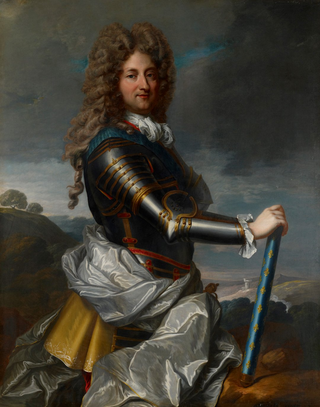
Philippe II, Duke of Orléans, was a French prince, soldier, and statesman who served as Regent of the Kingdom of France from 1715 to 1723. He is referred to in French as le Régent. He was the son of Monsieur Philippe I, Duke of Orleans, and Madame Elisabeth Charlotte, Duchess of Orléans. Born at his father's palace at Saint-Cloud, he was known from birth by the title of Duke of Chartres.

The Régence was the period in French history between 1715 and 1723 when King Louis XV was considered a minor and the country was instead governed by Philippe II, Duke of Orléans as prince regent. This was not the only regency in French history but the name is still associated with this period.

Mariana Victoria of Spain was an Infanta of Spain by birth and was later the Queen of Portugal as wife of King Joseph I. She acted as regent of Portugal in 1776–1777, during the last months of her husband's life, and as advisor to her daughter, Maria I of Portugal, during her reign.
Infante, also anglicised as "infant" or translated as "prince", is the title and rank given in the Iberian kingdoms of Spain and Portugal to the sons and daughters (infantas) of the king, regardless of age, sometimes with the exception of the heir apparent or heir presumptive to the throne who usually bears a unique princely or ducal title. A woman married to a male infante was accorded the title of infanta if the marriage was dynastically approved, although since 1987 this is no longer automatically the case in Spain. Husbands of born infantas did not obtain the title of infante through marriage, although they were occasionally elevated to the title de gracia at the sovereign's command.

Elisabeth of France or Isabella of Bourbon was Queen of Spain from 1621 to her death and Queen of Portugal from 1621 to 1640, as the first spouse of King Philip IV & III. She served as regent of Spain during the Catalan Revolt in 1640–42 and 1643–44.

Louis-Michel van Loo was a French painter.
The Spanish royal family constitutes the Spanish branch of the House of Bourbon, also known as the House of Bourbon-Anjou. The royal family is headed by King Felipe VI and currently consists of the King; Queen Letizia; their children, Leonor, Princess of Asturias, and Infanta Sofía; and Felipe's parents, King Juan Carlos I and Queen Sofía. The royal family lives at the Zarzuela Palace in Madrid, although their official residence is the Royal Palace of Madrid. The membership of the royal family is defined by royal decree and consists of: the King of Spain, the monarch's spouse, the monarch's parents, his children, and the heir to the Spanish throne.

Philip was Duke of Parma from 18 October 1748 until his death in 1765. A Spanish infante by birth, he was born in Madrid as the second son of King Philip V and Queen Elisabeth. He became Duke of Parma as a result of the 1748 Treaty of Aix-la-Chapelle. The duchy had earlier been ruled by Philip's elder brother, the future Charles III of Spain, and by their maternal ancestors. Philip founded the House of Bourbon-Parma, a cadet line of the House of Bourbon. He was a first cousin and son-in-law of the French king Louis XV.
Maria of Portugal is the name of several Portuguese queens, queens consort, princesses and infantas, some of whom reigned as Queen of Spain or other lands:
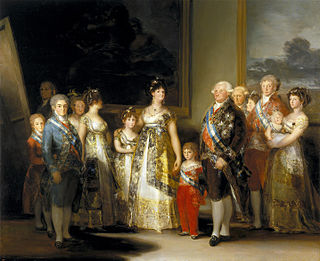
Charles IV of Spain and His Family is an oil-on-canvas group portrait painting by the Spanish artist Francisco Goya. He began work on the painting in 1800, shortly after he became First Chamber Painter to the royal family, and completed it in the summer of 1801.
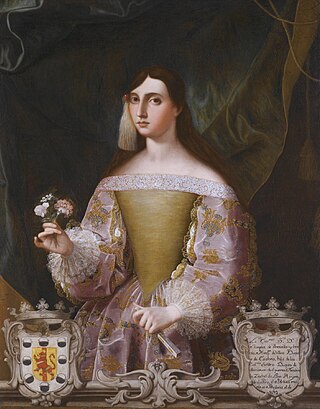
Alonso Miguel de Tovar, sometimes called Tobar (1678–1752) was a Spanish baroque painter, appointed court painter by Philip V in 1723.
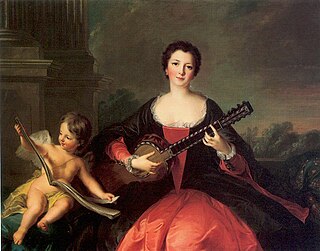
Philippine Élisabeth Charlotte d'Orléans was the daughter of Philippe II, Duke of Orléans, and his wife, Françoise-Marie de Bourbon, the youngest legitimised daughter of King Louis XIV and Madame de Montespan. As a member of the reigning House of Bourbon and the House of Orléans, Philippine Élisabeth was a Princesse du Sang. She died of smallpox at the age of 19.

Charles III of Spain is the third surviving son of the first Bourbon King of Spain Philip V and Elisabeth Farnese. The descendants of Charles III of Spain, are numerous. Growing up in Madrid till he was 16, he was sent to the Italian Sovereign Duchy of Parma and Piacenza which, through his mother Elisabeth of Parma, was considered his birthright. Charles married only once, to the cultured Princess Maria Amalia of Saxony, with whom he had 13 children; 8 of these reached adulthood and only 4 of these had issue.

Louise-Élisabeth of France was a French princess, a fille de France. She was the eldest daughter of King Louis XV and Queen Maria Leszczyńska, and the twin sister of Henriette of France, and she was the only one of his legitimate daughters who married. She married Infante Philip of Spain, who inherited the Duchy of Parma and Piacenza through his mother in 1748. Infante Philip was her father's first cousin; both men were grandsons of Louis, Grand Dauphin. Thereafter, Élisabeth and her husband founded the House of Bourbon-Parma. She functioned as the de facto ruler of the Duchy of Parma between 1748 and 1759.

Jean Ranc was a French painter, mainly active in portraiture. He trained under his father Antoine Ranc and his father's former student Hyacinthe Rigaud and served in the courts of both Louis XV of France and Philip V of Spain.

María Josefa Carmela of Spain was a Princess of Naples and Sicily by birth. At the accession of her father to the Spanish throne as Charles III, she became an Infanta of Spain. Born and raised in Naples, she arrived in Spain with her family in October 1759, at age fifteen. She lived at the court of her father and later with her brother Charles IV of Spain. She remained unmarried.

The Family of Philip V is an oil-on-canvas painting by the French artist Louis-Michel van Loo, completed in 1743. It features life-sized depictions of Philip V of Spain and his family. The painting depicts the royal family in a fictional room and is in the style of French baroque and rococo art. The painting is one of a trio of paintings which bear the same name and are dated 1723 by Jean Ranc, a smaller 1738 version and the 1743 rendition.

The Exchange of the Princesses refers to the ceremonies of the double marriage of Spanish Infanta Mariana Victoria of Spain to the heir of the Portuguese throne, Joseph, Prince of Brazil, and of her older half-brother Ferdinand, Prince of Asturias to Joseph's sister the Infanta Barbara of Portugal, in January 1729.

















